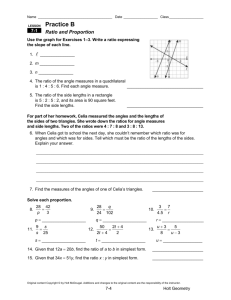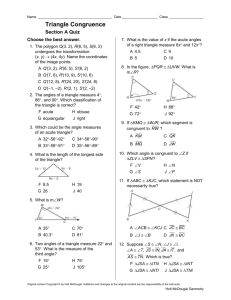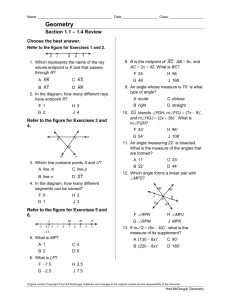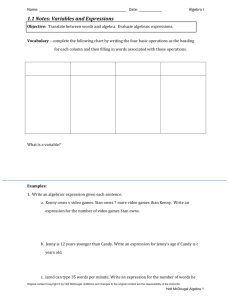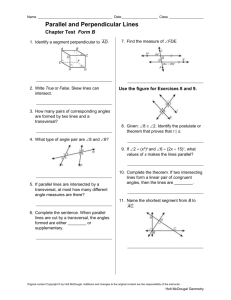Gender Roles
advertisement
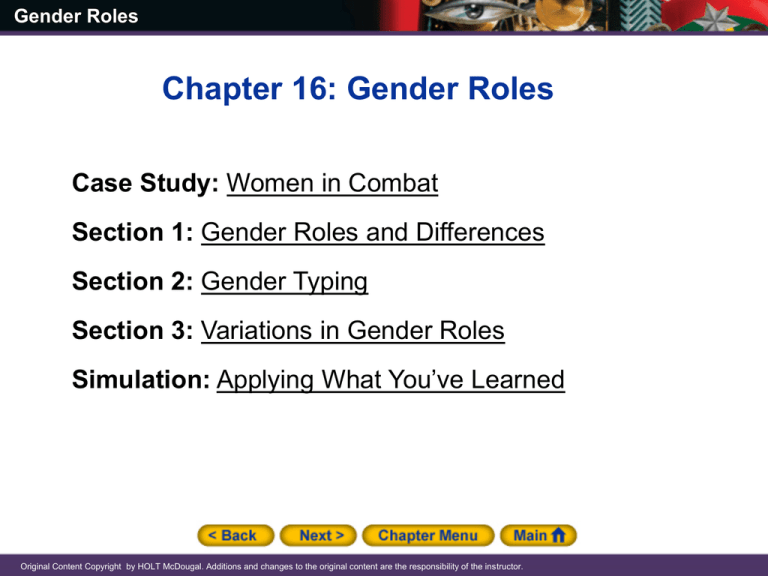
Gender Roles Chapter 16: Gender Roles Case Study: Women in Combat Section 1: Gender Roles and Differences Section 2: Gender Typing Section 3: Variations in Gender Roles Simulation: Applying What You’ve Learned Original Content Copyright by HOLT McDougal. Additions and changes to the original content are the responsibility of the instructor. Gender Roles Case Study: Women in Combat Although Monica Lin Brown was awarded the Silver Star for gallantry in combat, she was removed form her unit to a safe post, against her wishes. U.S. law prohibits women from serving in units whose primary mission involves direct ground combat. According to Army reports, female combat troops are prepared and are needed, but Congress has retained the restriction. If women were inherently gentle and afraid, then women would not belong in combat. So what one thinks about these issues depends on one’s expectations about how men and women behave. Original Content Copyright by HOLT McDougal. Additions and changes to the original content are the responsibility of the instructor. Gender Roles Section 1 at a Glance Gender Roles and Differences • Gender roles are different sets of behaviors that a culture considers appropriate for males and females. • Gender stereotypes are oversimplified, fixed beliefs about what behaviors are appropriate for males and females. • Men and women typically exhibit physical, cognitive, behavioral, and personality differences. • Differences between men and women are both inherited and learned. Original Content Copyright by HOLT McDougal. Additions and changes to the original content are the responsibility of the instructor. Gender Roles Section 1 at a Glance (cont.) Gender Roles and Differences • For the most part, the range of differences among all men or among all women is greater than the differences between the typical or average man and woman. Original Content Copyright by HOLT McDougal. Additions and changes to the original content are the responsibility of the instructor. Gender Roles Gender Roles and Differences Main Idea Some psychological differences between males and females are the product of biology and some are learned. Reading Focus • What is a gender role? What is a gender stereotype? • What differences characterize men and women? • Do gender roles cause or reflect personality differences between men and women? Original Content Copyright by HOLT McDougal. Additions and changes to the original content are the responsibility of the instructor. Gender Roles How do gender roles affect career success? Original Content Copyright by HOLT McDougal. Additions and changes to the original content are the responsibility of the instructor. Gender Roles Understanding Roles and Stereotypes Gender refers to the sex of an individual, either male or female. Like hair color and eye color, gender is a biological trait that is fixed by the genes before birth. Gender Roles Gender Stereotypes • Widely accepted societal expectations about how males and females should behave. • Fixed and oversimplified beliefs about the ways in which men and women ought to behave. • Unlike gender itself, gender roles are not genetically determined. • U.S. gender stereotypes similar to other industrialized nations. • Gender roles can describe behavior or dictate it. • Many jobs are still stereotyped as primarily for men or women. Original Content Copyright by HOLT McDougal. Additions and changes to the original content are the responsibility of the instructor. Gender Roles Reading Check Compare and Contrast What is the difference between a gender role and a gender stereotype? Answer: A gender role defines appropriate masculine and feminine behavior in a particular culture, while a gender stereotype oversimplifies and solidifies those ideas into rigid beliefs about male and female behavior. Original Content Copyright by HOLT McDougal. Additions and changes to the original content are the responsibility of the instructor. Gender Roles Physical and Cognitive Differences Physical Differences Cognitive Differences • Men and women differ in primary and secondary sex characteristics. • Modern assessments show no gender differences in intelligence. • These statements describe the average man or woman, not every man and every woman. • Women seem to learn language faster and have stronger verbal skills. • Men seem to be able to manipulate visual images better. Explaining Gender Differences In most cases, differences are small; differences are group differences; some differences may reflect cultural differences; women obtain most of the college degrees in some sciences and maths. Original Content Copyright by HOLT McDougal. Additions and changes to the original content are the responsibility of the instructor. Gender Roles Original Content Copyright by HOLT McDougal. Additions and changes to the original content are the responsibility of the instructor. Gender Roles Reading Check Identify Cause and Effect What are the two general causes of physical and cognitive differences between men and women? Answer: They are probably caused by both biological and cultural differences. Original Content Copyright by HOLT McDougal. Additions and changes to the original content are the responsibility of the instructor. Gender Roles Original Content Copyright by HOLT McDougal. Additions and changes to the original content are the responsibility of the instructor. Gender Roles Differences in Personality and Behavior Communication Styles • Women tend to exceed men in trust and nurturance (affectionate care). • A common masculine stereotype is the “strong, silent type.” • Other differences include communication styles, levels of aggression, and traits desired in a mate. • In reality men talk more than women do in mixed-sex groups. Aggression Mate Selection • Primarily men who fight in war and compete in sports and games. • Both genders want traits such as cleanliness, good complexion, etc. • Men are more likely to become aggressive and are more physically aggressive than women. • Men more swayed by physical appearance than women. • Women talk more about intimate matters. • Women more interested in men with steady jobs and dependability. Original Content Copyright by HOLT McDougal. Additions and changes to the original content are the responsibility of the instructor. Gender Roles Original Content Copyright by HOLT McDougal. Additions and changes to the original content are the responsibility of the instructor. Gender Roles Reading Check Identify Supporting Details What are some apparent differences between males and females? Answer: Women exceed men in nurturing, trust, and willingness to talk about their feelings, while men exceed women in assertiveness and toughmindedness; the sexes also differ in communication style and in what they look for in a mate. Original Content Copyright by HOLT McDougal. Additions and changes to the original content are the responsibility of the instructor. Gender Roles Current Research in Psychology The Emotional Development of Boys Since the late 1990s, numerous researchers have shown interest in how boys learn what it is to be a man. • Carol Gilligan proposed to understand girls on their own terms. • Others showed strict gender division shortchanges both men and women. • Society's messages result in constrained emotional development. • Boys learn to be tough, hide weakness, and avoid intimacy. • Boys are cut off from close friendships and receive mostly negative attention from teachers. • These lessons can breed antisocial behavior, depression, and violence. Original Content Copyright by HOLT McDougal. Additions and changes to the original content are the responsibility of the instructor. Gender Roles Thinking Critically • What traits do you think make for an ideal male role model? • What would you suggest to improve the ways in which boys and girls learn gender roles? Original Content Copyright by HOLT McDougal. Additions and changes to the original content are the responsibility of the instructor. Gender Roles Original Content Copyright by HOLT McDougal. Additions and changes to the original content are the responsibility of the instructor. Gender Roles Section 2 at a Glance Gender Typing • Gender typing refers to children’s self-identification with a gender and their acquisition of gender traits and roles. • Biological factors in gender typing include genetics and hormones. • Psychoanalytical theory, social learning theory, and schema theory explain gender typing in distinct ways. Original Content Copyright by HOLT McDougal. Additions and changes to the original content are the responsibility of the instructor. Gender Roles Gender Typing Main Idea Several different theories attempt to explain how children acquire their gender roles. Reading Focus • What is gender typing? • How do biological views help explain gender typing? • What psychological views relate to gender typing? Original Content Copyright by HOLT McDougal. Additions and changes to the original content are the responsibility of the instructor. Gender Roles Does advertising teach gender differences, or does it reflect them? Original Content Copyright by HOLT McDougal. Additions and changes to the original content are the responsibility of the instructor. Gender Roles Understanding Gender Typing • How do differences in physical strength, intellectual abilities, and communication styles develop? • Gender typing: the development of gender roles • Research shows that children as young as two-and-a-half years have developed ideas about what traits characterize genders. • Two general categories of explanations: – Biological process governed by natural chemical differences – Psychological process involving learning, socialization, and interpersonal relations Original Content Copyright by HOLT McDougal. Additions and changes to the original content are the responsibility of the instructor. Gender Roles Reading Check Define What is gender typing? Answer: process of gender role development Original Content Copyright by HOLT McDougal. Additions and changes to the original content are the responsibility of the instructor. Gender Roles Original Content Copyright by HOLT McDougal. Additions and changes to the original content are the responsibility of the instructor. Gender Roles Biological Views Genetics • Traits that help individuals survive and reproduce tend to be passed on to future generations. Some anthropologists argue that the traits that made early men successful hunters and early women successful child-rearers have been passed down to today. • New evidence suggests ancient gender roles may not have been as rigid as scholars once thought. • Some critics argue that biology does not dictate human behaviors. Hormones • Some believe that sex hormones shape brains before birth. • Most actions require both sides of the brain, but some, such as speech, require only one. Lateralization is the specialization of the two sides of the brain. • Some evidence suggests testosterone levels affect brain growth. Original Content Copyright by HOLT McDougal. Additions and changes to the original content are the responsibility of the instructor. Gender Roles Reading Check Identify Supporting Details How do genes and hormones affect gender typing? Answer: Genes may influence the development of certain traits and abilities in males and females, while hormones may influence the different development of the two sides of the brain in males and females. Original Content Copyright by HOLT McDougal. Additions and changes to the original content are the responsibility of the instructor. Gender Roles Original Content Copyright by HOLT McDougal. Additions and changes to the original content are the responsibility of the instructor. Gender Roles Psychological Views Psychoanalytic Theory • Freud argues that gender typing can be explained in terms of gender identification, which occurs between the ages of three and five. • At the beginning of this period children seek the attention of the parent of the opposite sex, but by the end come to identify with the parent of the same sex. • The child internalizes the standards of the same-sex parent. • Studies show that children develop roles earlier than this theory allows. Original Content Copyright by HOLT McDougal. Additions and changes to the original content are the responsibility of the instructor. Gender Roles Psychological Views (cont'd.) Social-Learning Theory • This theory states that gender roles are learned like other behaviors through two processes: reinforcement and modeling. • Social-learning theorists argue that reinforcement of appropriate gender role behavior starts almost from the moment of birth. • Type of play varies between genders, as do types of preferred toys. • Modeling: social learning that occurs through observation and imitation of others • If gender roles are learned, then they are changeable. Original Content Copyright by HOLT McDougal. Additions and changes to the original content are the responsibility of the instructor. Gender Roles Psychological Views (cont'd.) Gender-Schema Theory • Children themselves play an active role in developing genderappropriate behavior by forming their own concepts about gender and then shaping their behavior so that it conforms to their gender concepts. • Gender schema: a cluster of ideas about physical qualities, behaviors, and personality traits associated with one sex or the other. • Once a schema is formed, children try to live up to it. Both the biological and the psychological views of gender typing help us understand the differences in behavior between men and women. Original Content Copyright by HOLT McDougal. Additions and changes to the original content are the responsibility of the instructor. Gender Roles Original Content Copyright by HOLT McDougal. Additions and changes to the original content are the responsibility of the instructor. Gender Roles Reading Check Summarize How do social learning theory and schema theory explain gender typing? Answer: In both, infants observe how others behave and mimic the behavior. Original Content Copyright by HOLT McDougal. Additions and changes to the original content are the responsibility of the instructor. Gender Roles Section 3 at a Glance Variations in Gender Roles • Gendered behavior differs within societies at different times. • Gendered behavior differs between different societies. Original Content Copyright by HOLT McDougal. Additions and changes to the original content are the responsibility of the instructor. Gender Roles Variations in Gender Roles Main Idea Gender roles differ in different societies and change over time. Reading Focus • How have gender roles varied over time? • What aspects of gender vary among different cultures? Original Content Copyright by HOLT McDougal. Additions and changes to the original content are the responsibility of the instructor. Gender Roles How many stay-at-home dads do you know? Original Content Copyright by HOLT McDougal. Additions and changes to the original content are the responsibility of the instructor. Gender Roles Variation in Gender Roles Through Time • In Western society, gender roles have changed dramatically over time. • Throughout most of history, women were expected to be the child rearers and men were expected to provide food and safety for women and children. • Gender roles were both more distinct and more rigid than they are in contemporary Western society. Gender in the Modern United States • During the mid-20th century, women were expected to marry, stay at home, and care for the house and children. • In 2000, 70 percent of women were working or seeking a job. • Today husbands and wives share chores, child rearing, and wage earning. Original Content Copyright by HOLT McDougal. Additions and changes to the original content are the responsibility of the instructor. Gender Roles Click on the image above to play the Interactive. Original Content Copyright by HOLT McDougal. Additions and changes to the original content are the responsibility of the instructor. Gender Roles Reading Check Identify Supporting Details In what ways have gender differences in the United States changed? Answer: They have become more flexible, with more women working outside the home, remaining unmarried, being single parents, and taking part in activities such as sports. Men have assumed more housekeeping and child-raising duties and it is now acceptable for men to wear jewelry and other adornments. Original Content Copyright by HOLT McDougal. Additions and changes to the original content are the responsibility of the instructor. Gender Roles Cultural Variation • Ethnography: study of the lifestyles and behaviors of a group of people • Margaret Mead studied three groups of people and discovered the differences among them. – Mundugumor: both men and women were very aggressive – Arapesh: both men and women were gentle and peaceful – Tchambuli: men spent most of their time rearing children, women spent most of their time catching fish • Although Mead’s critics claim her work was biased because of her own view of gender roles, the idea that gender norms vary across cultures has become widely accepted. Original Content Copyright by HOLT McDougal. Additions and changes to the original content are the responsibility of the instructor. Gender Roles Reading Check Identify Main Ideas What do cultural differences suggest about how gender roles are acquired? Answer: that they are learned, not inborn Original Content Copyright by HOLT McDougal. Additions and changes to the original content are the responsibility of the instructor. Gender Roles Cultural Diversity and Psychology Gender Roles Around the World Studies show that men’s and women’s roles are a cultural product and not solely biological. Ethnographic studies attempt to assess the ways in which gender roles vary by society. • Employment is an important area where gender roles are found. • Whether women work, and in what jobs they work, are choices dictated by cultural norms. • Some societies strictly prohibit women from appearing in public. • Men’s and women’s roles across cultures have become more alike as societies around the world have become more industrialized, participate more in a world economy, and are increasingly inundated by worldwide news and entertainment. Original Content Copyright by HOLT McDougal. Additions and changes to the original content are the responsibility of the instructor. Gender Roles Original Content Copyright by HOLT McDougal. Additions and changes to the original content are the responsibility of the instructor. Gender Roles Thinking Critically • In what ways do women’s roles in different societies differ? • To what extent do you think men and women choose their gender roles? Original Content Copyright by HOLT McDougal. Additions and changes to the original content are the responsibility of the instructor. Gender Roles Simulation: Applying What You’ve Learned Identifying Gender Stereotypes How accurate are gender stereotypes? 1. Introduction • In this lab, you will role-play to portray the different genders. • As a class, make a list of roles or characters that include stereotypical gender traits. • Pair off and create a scenario for your roles. 2. Initial Preparation • Brainstorm as many gendered roles as you can—both stereotypical and nonstereotypical variations. • Draw a card from the pile and find a partner. • Enact your scenario for the class. Original Content Copyright by HOLT McDougal. Additions and changes to the original content are the responsibility of the instructor. Gender Roles Simulation (cont'd.) 3. Creating the Scenarios 4. Presenting and Observing the Scenarios • Work with your partner to create a scenario using your gender stereotypes. • As each group performs, look for identifying markers that will identify gender roles. • Think of five aspects of your role’s personality and behavior. • After each pair has presented their scenarios, match up willing participants to portray their gender types extemporaneously. • Create a scenario that showcases the aspects you and your partner have chosen. • Provide many clues. • Practice your script. • Try impromptu scenarios with three or four characters. Original Content Copyright by HOLT McDougal. Additions and changes to the original content are the responsibility of the instructor. Gender Roles Simulation (cont'd.) 5. Discussion • As a class, discuss the following: • Were the stereotypical gender types easier to identify than those that were nontraditional? Why? • What aspects made it easiest to identify a gender role? • What was revealed in the scenarios? Original Content Copyright by HOLT McDougal. Additions and changes to the original content are the responsibility of the instructor.


